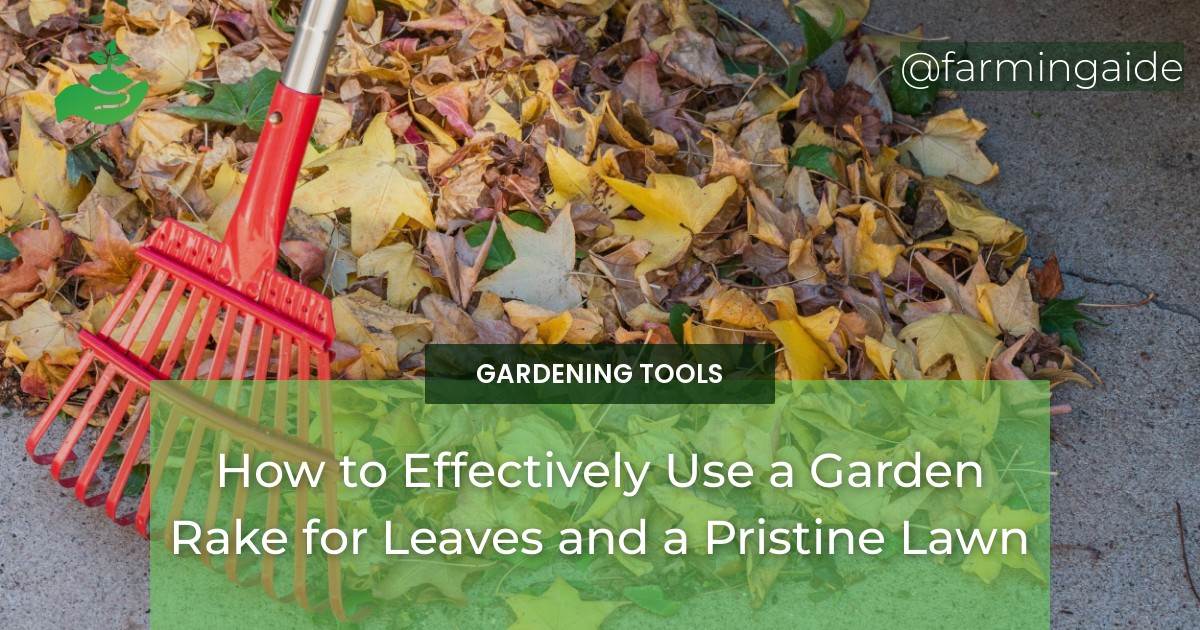A well-maintained lawn is the pride of any homeowner. However, with the changing of seasons comes the daunting task of leaf cleanup. As leaves begin to fall, they can quickly accumulate and create a messy and unsightly lawn. Many homeowners turn to the trusty garden rake to tackle this chore, but are often left with aches and pains and an incomplete job. In order to achieve a pristine lawn, it is important to know how to effectively use a garden rake. Mastering the art of leaf cleanup not only ensures a visually appealing lawn, but also promotes healthy grass growth by allowing sunlight and nutrients to reach the soil. In this article, we will discuss the proper techniques and tools needed to effectively use a garden rake for leaf cleanup. From choosing the right rake for your lawn to utilizing proper technique, we will guide you through the process of mastering leaf cleanup and achieving a pristine lawn. By following these tips and tricks, you will be able to confidently tackle leaf cleanup and maintain the beauty of your lawn all year round.
Table of Contents
Choose the right garden rake.
To effectively clean up leaves and achieve a pristine lawn, selecting the right garden rake is crucial. The key is to consider the specific features that will enhance the rake’s performance for leaf cleanup. Firstly, opt for a rake with flexible and durable tines. These tines should be able to glide smoothly over the ground, collecting leaves without damaging the grass or soil. Additionally, a wide rake head will cover more ground, making the cleanup process more efficient. Look for a rake with an adjustable handle length to ensure comfortable use and reduce strain on your back. Lastly, consider the material of the rake handle. A sturdy and lightweight handle, such as fiberglass or aluminum, will provide both durability and ease of use. By carefully choosing a garden rake designed specifically for leaves, you can master leaf cleanup and achieve a pristine lawn effortlessly.
Start from the edges first.
When it comes to using a garden rake for leaves, a helpful technique is to start from the edges first. This approach allows you to systematically work your way towards the center of your lawn, ensuring that no leaves are left behind. By beginning at the edges, you can create neat piles as you gather the fallen leaves, making the overall cleanup process more manageable. Additionally, starting from the edges prevents you from accidentally spreading leaves back onto areas you have already cleaned. This method provides a structured and efficient approach to leaf cleanup, resulting in a pristine lawn that is free from debris.
Use a push and pull motion.
One effective technique to utilize when using a garden rake for leaves is to employ a push and pull motion. Rather than simply raking the leaves in one direction, incorporating both a pushing and pulling motion helps to gather and collect the fallen foliage more efficiently. Start by pushing the rake forward, using firm and deliberate strokes to gather the leaves into manageable piles. Then, pull the rake towards you, ensuring that the tines of the rake penetrate through the leaf litter and effectively collect them. This push and pull technique allows for better control and coverage, ensuring that no leaves are left scattered across your lawn. By mastering this motion, you can achieve a more thorough and effective leaf cleanup, leaving your lawn looking pristine and well-maintained.
Work in small sections.
Another helpful tip when utilizing a garden rake for leaves is to work in small sections. Instead of trying to tackle the entire lawn at once, divide it into smaller areas and focus on one section at a time. This approach allows you to give your full attention and effort to each area, ensuring a more thorough cleanup. By concentrating on smaller sections, you can also maintain better control and accuracy with your rake, making sure to collect every last leaf. Additionally, working in small sections prevents you from feeling overwhelmed and helps you stay organized throughout the leaf cleanup process. Remember, taking it step by step will ultimately lead to a pristine and well-manicured lawn.
Gather leaves into piles.
Once you have gathered the necessary tools and prepared your garden rake for leaves, it’s time to get to work on the actual cleanup process. The first step is to gather the leaves into piles. Start by selecting a designated area where you plan to relocate the leaves, such as a compost bin or a designated leaf disposal site. Begin by raking the leaves into small, manageable piles, using long sweeping motions to collect them efficiently. It’s important to rake in one direction to avoid scattering the leaves and creating more work for yourself. As you rake, be mindful of any obstacles in your path, such as trees, flower beds, or lawn furniture, and work around them accordingly. Once you have created a pile, use the rake to compact and shape it, ensuring a neat and consolidated stack of leaves. Repeat this process throughout your lawn, focusing on one section at a time, until all the leaves have been gathered into piles. This methodical approach will not only make the cleanup more manageable but also result in a well-organized and pristine lawn.
Rake leaves onto a tarp.
Next, carefully position a tarp near the first pile of leaves. The tarp should be large enough to hold all the gathered leaves comfortably. Place one edge of the tarp next to the pile and secure it in place with rocks or stakes to prevent it from moving while you work. Now, using your garden rake for leaves, carefully scoop up the piles and transfer them onto the tarp. Start with the closest pile and work your way towards the furthest, ensuring that you are depositing the leaves evenly across the tarp. This method helps to minimize the risk of leaves falling off or getting scattered as you move them. Once all the leaves have been transferred onto the tarp, you can easily drag it to your designated leaf disposal site or compost bin for further processing. By utilizing a tarp in this manner, you not only simplify the process of leaf cleanup but also prevent any unnecessary strain on your back from repeatedly bending over to collect the leaves.
Use a leaf blower first.
To effectively use a garden rake for leaves, it is recommended to use a leaf blower first. Using a leaf blower to gather the majority of the leaves into piles will make your job with the garden rake much easier. The powerful gusts of air from the leaf blower will help to move the leaves from hard-to-reach areas such as crevices and corners, making them more accessible for raking. By removing the bulk of the leaves with a leaf blower, you can then use the garden rake to gather any remaining leaves and tidy up the area. This two-step process will save you time and effort, ensuring a more efficient and thorough leaf cleanup. So, before you start raking, grab your leaf blower and make the task of using a garden rake for leaves much more manageable.
Adjust rake for different surfaces.
When using a garden rake for leaf cleanup, it’s important to adjust the rake for different surfaces. Not all areas of your lawn or garden may have the same level of debris or thickness of leaves. By adjusting the angle and depth of the rake, you can effectively adapt to the specific conditions of each surface. For example, a flatter angle and shallow depth may be suitable for lightly covered areas, while a steeper angle and deeper depth may be necessary for denser patches of leaves. By making these adjustments, you can ensure that the tines of the rake penetrate the surface and efficiently gather the leaves without causing unnecessary damage to your lawn. Mastering the art of adjusting the rake for different surfaces will greatly contribute to achieving a pristine and well-maintained lawn during your leaf cleanup endeavors.
Clean up debris and twigs.
To effectively clean up debris and twigs using a garden rake, it is essential to follow proper techniques. Begin by surveying the area and identifying any large debris or branches that may need to be removed separately. Once the larger items have been cleared, start raking the smaller debris and twigs towards a designated collection area. Use smooth, rhythmic motions with the rake to gather and pile the debris efficiently. Remember to alternate your grip and stance to avoid strain and fatigue. Additionally, be mindful of any sensitive areas, such as flower beds or delicate plants, and use a lighter touch to avoid damaging them. Regularly empty the gathered debris to prevent clogging or overloading the rake. By employing these techniques, you can effectively clean up debris and twigs using a garden rake, resulting in a pristine and well-maintained lawn.
How Can Using a Wheelbarrow Help with Leaf Cleanup and Maintaining a Pristine Lawn?
Using a wheelbarrow in the garden can make leaf cleanup and lawn maintenance a breeze. Instead of lugging heavy piles of leaves and debris, simply load them into the wheelbarrow and transport them to the compost pile or disposal area. This saves time and effort, leaving your lawn looking pristine and well-manicured.
Don’t forget to compost leaves.
When it comes to leaf cleanup, it’s important not to overlook the option of composting. Composting leaves is not only environmentally friendly but also beneficial for your garden. Leaves are a fantastic source of organic matter that can enrich the soil and provide essential nutrients for your plants. By using a garden rake specifically designed for leaves, you can easily gather them into piles and transfer them to a compost bin or designated composting area. Over time, the leaves will break down, transforming into nutrient-rich compost that can be used to fertilize your plants. Remember to mix the leaves with other organic materials such as kitchen scraps or grass clippings for optimal decomposition. So, before you dispose of those fallen leaves, consider composting them and harnessing their potential to nourish your garden.
In conclusion, using a garden rake for leaf cleanup is an effective and efficient way to maintain a pristine lawn. By following these tips and techniques, you can master the art of leaf cleanup and have a beautiful yard all season long. Remember to choose the right rake for the job, work in small sections, and use proper form to avoid unnecessary strain. With a little bit of practice, you’ll be able to quickly and easily clean up any amount of leaves, leaving your lawn looking tidy and well-maintained. So go out and give it a try, your lawn will thank you for it!


